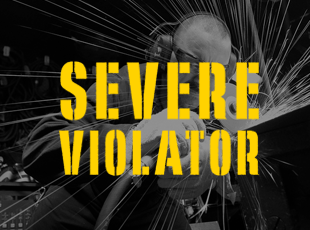Nearly five years ago, OSHA launched one of the largest programs to date to highlight employers “who have demonstrated indifference to their OSH Act obligations by willful, repeated, or failure-to-abate violations.” Simply titled the Severe Violator Enforcement Program (SVEP), this program was launched in June 2010 to shame (or disclose) employers who egregiously ignore occupational health code.
Effectively replacing the often criticized Enhanced Enforcement Program (EEP), the SVEP launched to provide more stringent standards and facilitate follow-up inspections for violators.
SVEP was created as a means of focusing on and heavily penalizing employers whom the agency believes have shown indifference to their safety and health obligations by issuing in repeat or willful violations. An employer in the SVEP can expect increased and more comprehensive inspections – often enterprise-wide – and substantial penalty and other abatement enhancements if violations are found.
This wouldn’t be tailored to ‘severe’ violators if every citation landed an employer on the list. Of the 463 currently on the list, these employers have met at least one of the following criteria:
- Fatality/Catastrophe Criterion. A fatality/catastrophe inspection in which OSHA finds oneor more willful or repeated violations or failure-to-abate notices based on a serious violation related to a death of an employee or three or more hospitalizations.
- Non-Fatality/Catastrophe Criterion Related to High-Emphasis Hazards. An inspection in which OSHA finds twoor more willful or repeated violations or failure-to-abate notices (or any combination of these violations/notices), based on high gravity serious violations related to a High-Emphasis Hazard as defined in Section XII. (p. 5).
- Non-Fatality/Catastrophe Criterion for Hazards Due to the Potential Release of a Highly Hazardous Chemical (Process Safety Management). An inspection in which OSHA finds threeor more willful or repeated violations or failure-to-abate notices (or any combination of these violations/notices), based on high gravity serious violations related to hazards due to the potential release of a highly hazardous chemical, as defined in the PSM standard.
- Egregious Criterion. All egregious(e.g., per-instance citations) enforcement actions will be considered SVEP cases.
The SVEP Process
How does an employer make it onto the SVEP? Is there a way out? Safety and Health Magazine offered a simple flowchart on the topic in a recent article and infographic, The Path to SVEP.
Making It Off the SVEP Log
No matter what the situation, an SVEP violation is an embarrassing black mark on an employer’s name that will be there for at least three years. Lining out and removal are the two ways an employer may come off the SVEP Log.
Lining Out
A lineout occurs when an ISA, a Formal Settlement Agreement (FSA), or a court adjudication deletes or reclassifies the citations such that the case no longer qualifies for the SVEP and is therefore lined off the Log. Settlements may only delete or reclassify the citations such that the case no longer qualifies for the SVEP if there are factual changes based on the quality of evidence brought forth during settlement discussions.
Of the 434 employers on the list (October 2014), 152 are no longer in the program, possibly due to the lining out process, according to Safety + Health Magazine.
Removal
Removal occurs when an SVEP case is removed for meeting certain criteria of good behavior. According to the OSHA Press Release dated August 2012, an employer may be removed from the SVEP after a period of three years from the date of final disposition of the SVEP inspection citation items.
Final disposition may occur through failure to contest, settlement agreement, Review Commission final order, or court of appeals decision. To be removed from the SVEP, Employers must have
- Abated all SVEP–related hazards affirmed as violations
- Paid all final penalties
- Abided by and completed all settlement provisions
- Not received any additional serious citations related to the hazards identified in the SVEP inspection at the initial establishment or at any related establishments.
If an employer does not meet the criteria for removal, it will remain on the list for another three years. Currently, no employer has been removed from the program.
Tarnishing Reputations
Of the 463 currently on the list, 118 remain, but their business was adversely affected so much that either the worksite/workplace closed (49), employer went out of business (23), or operation cited has been discontinued at the worksite/workplace (46). Although correlation does not beget causation, landing on this list seems to have more than just the monetary cost of citations.
Protecting Yourself from Shame
Don’t let your company wear a scarlet letter on OSHA’s shame list. From tarnished reputations to monetary citations to the costs to fix everything later, the costs could be overbearing. Proactively protect your personnel, and learn the true Return on Safety.
Optimum Safety Management can help your company and safety team to protect your workers, resulting in increased productivity, better profitability, and of course, improved safety. Through our 30-point SMS Snapshot, we can help you recognize where your business stands, and learn how to make it safer.
Contact us today to learn more.
Related Resources
- SVEP Removal Criteria OSHA Press Release
- OSHA Regulation by Shaming
- Severe Violator Enforcement Program [OSHA Website]
- Continued Enforcement—Less Carrot, More Stick
- 2013 SVEP Whitepaper [OSHA Website]









